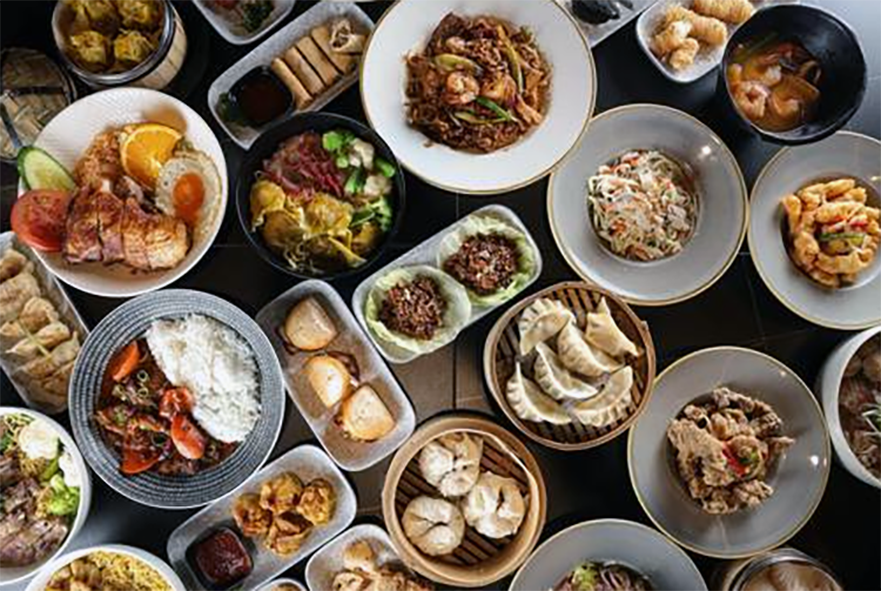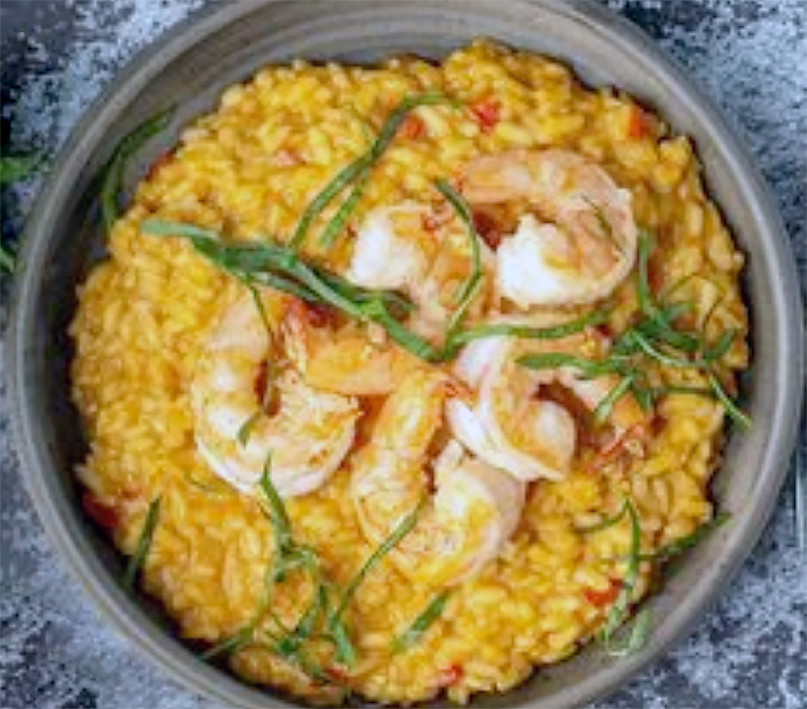FabulousFusionFood's Asian Fusion recipes Home Page
 A range of Asian Fusion dishes.
A range of Asian Fusion dishes.
Welcome to the summary page for FabulousFusionFood's Fusion Cuisine recipes. This page provides links to all the Fusion Cuisine and recipes presented on this site, with 186 recipes in total.
Fusion cuisine is a cuisine that combines elements of different culinary traditions that originate from different countries, regions, or cultures. Typically, cuisines of this type are not categorised according to any one particular cuisine style and have played a part in many contemporary restaurant cuisines since the 1970s. The exception to this might be Asian Cuisine,
The term fusion cuisine, added to the Oxford English Dictionary in 2002, is defined as "a style of cookery which blends ingredients and methods of preparation from different countries, regions, or ethnic groups; food cooked in this style."
Fusion food is created by combining various cooking techniques from different cultures to produce a new type of cuisine. Although it is commonly invented by chefs, fusion cuisine can occur naturally. Cuisines which get fused can either come from a particular region (such as East Asian cuisine and European cuisine), sub-region (such as Southwestern American cuisine and New Mexican cuisine or a country (such as Chinese cuisine, Japanese cuisine, Korean cuisine, French cuisine, Italian cuisine).
 A Thai-Italian Asian fusion dish of red curry risotto served topped with king prawns.Asia is enormous and all foods that include elements of dishes and ingredients anywhere from Turkey, through Asiatic Russia to the subcontinent, south and east Asia are all Asian fusion foods. This includes most Western Chinese and Thai dishes, Anglo-Indian foods, Koream fusion, Arab fusion and much more.
A Thai-Italian Asian fusion dish of red curry risotto served topped with king prawns.Asia is enormous and all foods that include elements of dishes and ingredients anywhere from Turkey, through Asiatic Russia to the subcontinent, south and east Asia are all Asian fusion foods. This includes most Western Chinese and Thai dishes, Anglo-Indian foods, Koream fusion, Arab fusion and much more.
Asian fusion restaurants which combine the various cuisines of different Asian countries have become popular in many parts of the United States, United Kingdom and Australia. Often featured are East Asian, Southeast Asian, and South Asian dishes alongside one another and offering dishes that are inspired combinations of such cuisines.[3] California cuisine is considered a fusion culture, taking inspiration particularly from Italy, France, Mexico], the idea of the European delicatessen, and East Asia, and then creating traditional dishes from these cultures with non-traditional ingredients – such as California pizza. In Australia, due to immigration, fusion cuisine is being reinvented and is becoming increasingly the norm at numerous cafes and restaurants, with Asian-fusion restaurants like Tetsuya's in Sydney ranking highly in The World's 50 Best Restaurants.
In the United Kingdom, fish and chips can be seen as an early fusion dish due to its marrying of ingredients stemming from Jewish, French, and Belgian cuisines. The same can be said about the first British curries, that developed out of Anglo-Indian cuisine with Victorian dishes being given Indian flavours.
Filipino cuisine is sometimes characterized as the 'original Asian fusion cuisine', combining native culinary traditions and ingredients with the very different cuisines of China, Spain, Malaysia, Thailand and Mongolia, among others, due to its unique colonial history. Food in Malaysia (also Indonesia) is another example of fusion cuisine which blends Malay, Javanese, Chinese and Indian and light influences from Thai, Portuguese, Dutch, and British cuisines. Oceanic cuisine combines the different cuisines of the various island nations.
I would argue that fusion cuisine is not a new thing, it's the nature of cookery itself. This may have started with early traders, and a good example is the introduction of curry styles from India into Vietnam and Thailand. And the more I examine historical cookery books, and the more I read the more of it I observe. Indeed, fusion cuisine has existed for millennia as a form of cross-cultural exchange, though the term was only defined in the late 1900s. Fusion cuisines is often associated with European colonialism, with mixtures of different cultures' cuisines assumed to have been adapted since the 16th century. But this history is much older. The Crusades brought new spices and sugarcane to Europe. The Romans adapted Greek cuisine and spread mediterranean plants throughout Europe. The development of Agriculture brought grains everywhere, making them staples. However, it is true that the quest for spices kicked-off the European age of exploration in the 16th Century and arguably introduced modern market economics.
Indo-Chinese cuisine is an example of how gradual migration and exchange across shared international borders contributes to fusion cuisine. Similar cases are Sino-Korean food emerging from Chinese diasporas in Korea and shared borders between Korea and Northeastern China, and Mexican-American cuisine influenced by Mexican immigration to the Southwest United States that combines Mexican, Indigenous American, and European flavours. Then there is Anglo-Indian cuisine that started in the 1850s with British nabobs in India, then accelerated with the establishment of the first curry houses in Britain, culminating in the development of dishes such as Chicken Tikka Masala and Baltis in Britain. This page brings together all the Asian-influenced dishes presented on this site.
The driving forces in Fusion Cuisine can be many and varied, from large international chain restaurants adapting their menus to better suit local customers, to chefs developing new recipes, to cross-cultural families developing their own dishes as a blend of both cultures. Australian cuisine has been strongly influenced by Asian dishes and many modern Australian recipes are classic examples of Asian Fusion cookery. Many of the dishes on this page originate in Australia.
Fusion cuisine is a cuisine that combines elements of different culinary traditions that originate from different countries, regions, or cultures. Typically, cuisines of this type are not categorised according to any one particular cuisine style and have played a part in many contemporary restaurant cuisines since the 1970s. The exception to this might be Asian Cuisine,
The term fusion cuisine, added to the Oxford English Dictionary in 2002, is defined as "a style of cookery which blends ingredients and methods of preparation from different countries, regions, or ethnic groups; food cooked in this style."
Fusion food is created by combining various cooking techniques from different cultures to produce a new type of cuisine. Although it is commonly invented by chefs, fusion cuisine can occur naturally. Cuisines which get fused can either come from a particular region (such as East Asian cuisine and European cuisine), sub-region (such as Southwestern American cuisine and New Mexican cuisine or a country (such as Chinese cuisine, Japanese cuisine, Korean cuisine, French cuisine, Italian cuisine).
 A Thai-Italian Asian fusion dish of red curry risotto served topped with king prawns.
A Thai-Italian Asian fusion dish of red curry risotto served topped with king prawns.Asian fusion restaurants which combine the various cuisines of different Asian countries have become popular in many parts of the United States, United Kingdom and Australia. Often featured are East Asian, Southeast Asian, and South Asian dishes alongside one another and offering dishes that are inspired combinations of such cuisines.[3] California cuisine is considered a fusion culture, taking inspiration particularly from Italy, France, Mexico], the idea of the European delicatessen, and East Asia, and then creating traditional dishes from these cultures with non-traditional ingredients – such as California pizza. In Australia, due to immigration, fusion cuisine is being reinvented and is becoming increasingly the norm at numerous cafes and restaurants, with Asian-fusion restaurants like Tetsuya's in Sydney ranking highly in The World's 50 Best Restaurants.
In the United Kingdom, fish and chips can be seen as an early fusion dish due to its marrying of ingredients stemming from Jewish, French, and Belgian cuisines. The same can be said about the first British curries, that developed out of Anglo-Indian cuisine with Victorian dishes being given Indian flavours.
Filipino cuisine is sometimes characterized as the 'original Asian fusion cuisine', combining native culinary traditions and ingredients with the very different cuisines of China, Spain, Malaysia, Thailand and Mongolia, among others, due to its unique colonial history. Food in Malaysia (also Indonesia) is another example of fusion cuisine which blends Malay, Javanese, Chinese and Indian and light influences from Thai, Portuguese, Dutch, and British cuisines. Oceanic cuisine combines the different cuisines of the various island nations.
I would argue that fusion cuisine is not a new thing, it's the nature of cookery itself. This may have started with early traders, and a good example is the introduction of curry styles from India into Vietnam and Thailand. And the more I examine historical cookery books, and the more I read the more of it I observe. Indeed, fusion cuisine has existed for millennia as a form of cross-cultural exchange, though the term was only defined in the late 1900s. Fusion cuisines is often associated with European colonialism, with mixtures of different cultures' cuisines assumed to have been adapted since the 16th century. But this history is much older. The Crusades brought new spices and sugarcane to Europe. The Romans adapted Greek cuisine and spread mediterranean plants throughout Europe. The development of Agriculture brought grains everywhere, making them staples. However, it is true that the quest for spices kicked-off the European age of exploration in the 16th Century and arguably introduced modern market economics.
Indo-Chinese cuisine is an example of how gradual migration and exchange across shared international borders contributes to fusion cuisine. Similar cases are Sino-Korean food emerging from Chinese diasporas in Korea and shared borders between Korea and Northeastern China, and Mexican-American cuisine influenced by Mexican immigration to the Southwest United States that combines Mexican, Indigenous American, and European flavours. Then there is Anglo-Indian cuisine that started in the 1850s with British nabobs in India, then accelerated with the establishment of the first curry houses in Britain, culminating in the development of dishes such as Chicken Tikka Masala and Baltis in Britain. This page brings together all the Asian-influenced dishes presented on this site.
The driving forces in Fusion Cuisine can be many and varied, from large international chain restaurants adapting their menus to better suit local customers, to chefs developing new recipes, to cross-cultural families developing their own dishes as a blend of both cultures. Australian cuisine has been strongly influenced by Asian dishes and many modern Australian recipes are classic examples of Asian Fusion cookery. Many of the dishes on this page originate in Australia.
The alphabetical list of all Asian Fusion recipes on this site follows, (limited to 100 recipes per page). There are 186 recipes in total:
Page 1 of 2
Page 1 of 2